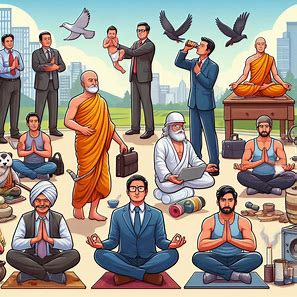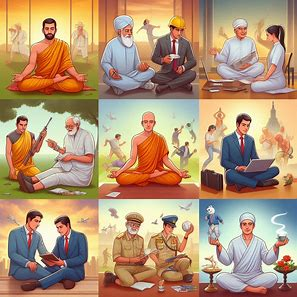Life as a Symphony of Actions
If we delve deeply into the essence of human existence, we uncover that life is essentially a tapestry woven from a series of actions. These actions manifest across various dimensions: physical, sensory, mental, emotional, and intellectual.
Physical Actions:
Voluntary and Involuntary
Physical actions
encompass every movement our bodies perform. These can be divided into
voluntary and involuntary actions:
Voluntary Actions These
are the conscious activities we engage in, such as standing, sitting, lying
down, walking, and talking. We initiate and control these actions deliberately.
Involuntary Actions These are the automatic functions that our body performs without our conscious effort. Examples include the beating of our heart, the digestion of food, and the regulation of our breathing. These processes continue seamlessly, sustaining our life without any need for our direct control.
Together, voluntary
and involuntary actions constitute the full spectrum of our physical
activities.
Sensory Actions: The
Gateway to Perception
Sensory actions involve our interactions with the world through our senses. They are facilitated by two types of nerve systems: sensory nerves and motor nerves.
Sensory Nerves These
enable us to perceive the world around us. We see with our eyes, hear with our
ears, taste with our tongue, smell with our nose, and feel textures with our
skin. These organs of perception (also known as the Gnana Indriyas in
philosophical terms) help us gather knowledge about our environment.
Motor Nerves: These
nerves drive our actions in the world. They govern the ability to serve (using
our hands), move (using our legs), speak (using our vocal cords), excrete, and
reproduce. These actions are performed by our organs of action, referred to as
the Karma Indriyas.
The combination of
sensory and motor actions forms the basis of our interaction with the world
through the senses.
Mental Actions: The Realm of Thoughts
Mental actions pertain
to the activities of our mind. When we contemplate something, plan an activity,
or consider a desire, we are engaging in mental action. For instance, thinking
about drinking coffee or deciding to watch a movie are mental activities. These
actions are the cognitive processes that continuously occur in our minds,
shaping our decisions and behaviors.
Emotional Actions: The
Language of Feelings
Our emotions are
another layer of action, distinct from mere thoughts. Emotional actions involve
the feelings we experience, such as love, compassion, anger, and joy. When we
express sentiments like, “I feel bad about this” or “I feel joy,” we are engaging
in emotional actions. These actions reflect our internal emotional states and
how we respond to different stimuli in our lives.
Intellectual Actions:
The Pursuit of Understanding
Intellectual actions
involve using our intelligence to comprehend and inquire about the world. When
we explore questions like “What is a television?” or “How does the moon affect
tides?” we engage in intellectual actions. These actions represent our quest
for knowledge and understanding, driving our curiosity and learning.
Conclusion
In essence, life can
be seen as a symphony of these various actions. Each type of action—whether
physical, sensory, mental, emotional, or intellectual—contributes to the rich,
dynamic experience of being human. Understanding and appreciating the interplay
of these actions can lead us to a deeper awareness of our lives and the world
around us.
Karma Yoga: The Path to
Spiritual Bliss
Karma Yoga, often regarded as the first step towards spiritual awakening, offers a profound and transformative approach to life. It teaches us that even if we do not achieve the ultimate spiritual goal, the journey itself is deeply enriching and brings immense joy and peace.
Understanding Karma
Yoga
Karma Yoga, or the
Yoga of Action, is about fulfilling our duties and responsibilities in life.
These duties encompass obligations towards ourselves, our family, society,
nature, our ancestors, the environment, and ultimately, God. The essence of
Karma Yoga lies in performing these duties with devotion, viewing them as an
offering to Ishvara, the Divine.
When we carry out our responsibilities as a form of worship, we begin to find joy and satisfaction in the actions themselves. While the results of our actions will inevitably follow, the focus of Karma Yoga is on enjoying the process and gracefully accepting whatever outcomes arise. This approach transforms mundane activities into a source of deep happiness and contentment.
The Divine Presence in
Everyday Actions
In the Bhagavad-gita,
Sri Krishna reveals the omnipresent nature of Ishvara: “I reside in the hearts
of every being. I pervade the whole world.” This profound insight teaches us
that we do not need to visit a temple or sacred place to connect with the Divine.
Ishvara is present everywhere and in everything we do. By cultivating the right
attitude—offering all our actions to Ishvara—we can find peace and purpose in
our daily lives.
Adopting this
dedicated mindset helps to dissolve many psychological and self-created
problems. When we perform our duties with a sense of devotion and surrender to
the Divine, we experience a sense of relief and clarity, as if our burdens are
lightened.
Swadharma and
Paradharma: Doing Your Own Duty
Karma Yoga emphasizes the importance of adhering to one's own duties, known as Swadharma. The Bhagavad-gita advises against Paradharma, which is attempting to perform someone else's duties. Each person has their own set of responsibilities and roles in life, and trying to take on others' roles or neglecting our own leads to imbalance and confusion.
Bhagavan's teaching is
clear: embrace your Swadharma and avoid Paradharma. Moreover, steer clear of
Adharma—actions that are harmful or unethical. Adharma, or Papa Karma, should
be avoided at all levels: in speech, action, and thought. By focusing on fulfilling
our own duties and avoiding harmful actions, we contribute to the harmony and
order of the world.
Karma
Yoga as a Path to Inner Peace
Practicing Karma Yoga
brings about inner peace and purity of heart. By performing our duties with
devotion and offering them to Ishvara, we create a sense of order and
tranquility around us. This practice helps us relax and fosters a deep sense of
peace. Conversely, when we fail to fulfill our responsibilities or engage in
activities that are not aligned with our duties, we experience anxiety and
restlessness.
Karma Yoga, therefore,
is not just about action but about the attitude with which we approach our
actions. By viewing our work as worship and dedicating it to the Divine, we can
transform our lives and find profound peace and fulfillment.
In summary, Karma Yoga
teaches us to perform our duties with love and devotion, to focus on the action
rather than the outcome, and to see all work as an offering to the Divine. This
approach leads to a harmonious and contented life, paving the way for spiritual
growth and enlightenment.
IF HE EXIST
I drive joy there was a doctor in Benaras who
spent 7 minutes in the morning and evening for mediation on God. Knowing this,
his colleagues and friends laughed at him. One day they argued that he was
wasting 7 precious minutes on something, which he had been misled into
believing. The doctor replied, “Well, if God does not exist, I agree that I am
wasting 7 minutes a day. But, if He exists? I am afraid you are wasting your
entire lifetime. I prefer to waste 7 minutes rather than a lifetime. Why should
you grudge me the 7minutes joy that I derive 4m.-
ILLUSTRATED REVIEW :In
euro cup saka 7 socred a goal , and
Bembolo 7 scored a goal














No comments:
Post a Comment